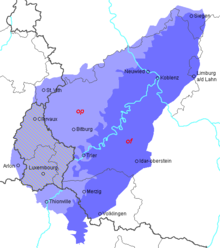lingvo.wikisort.org - Language
Moselle Franconian (German: Moselfränkisch, Luxembourgish: Muselfränkesch) is a West Central German language, part of the Central Franconian language area, that includes Luxembourgish. It is spoken in the southern Rhineland and along the course of the Moselle, in the Siegerland of North Rhine-Westphalia, throughout western Rhineland-Palatinate and Saarland, Luxembourg, the south of the German-speaking Community of Belgium and in the neighboring French département of Moselle (in Arrondissement of Boulay-Moselle). The Transylvanian Saxon dialect spoken in the Transylvania region of Romania is derived from this dialect as a result of the emigration of numerous "Transylvanian Saxons" between 1100 and 1300, primarily from areas in which the Moselle Franconian dialect was then spoken. Another variety of Moselle Franconian, the Hunsrik, is spoken in some rural areas of southern Brazil, brought by 19th century immigrants from the Hunsrück region in modern Germany.[1][2]
| Moselle Franconian | |
|---|---|
| Native to | Germany, France, Luxembourg, Belgium, Romania, Brazil |
| Region | North Rhine-Westphalia, Rhineland-Palatinate, Saarland, Lorraine, Liège |
Language family | Indo-European
|
Standard forms | |
| Official status | |
Official language in | |
Recognised minority language in | |
| Language codes | |
| ISO 639-3 | None (mis)Individual code: ltz – Luxembourgish |
| Glottolog | luxe1241 |
 Area where Moselle Franconian / Luxembourgish is spoken with the isogloss between usage of "op" and "of" (Standard German: auf) shown | |

Varieties
The transition between "dialect" and "separate language" is fluid.[3]

The Linguasphere Register[4] lists five dialects of Moselle Franconian (code 52-ACB-dc) with codes -dca to -dce:
- Trierisch (Rhineland-Palatinate, Luxembourg, northwestern Saarland)
- Eifelisch (Rhineland-Palatinate, East Belgium, Luxembourg, southern North Rhine-Westphalia)
- Untermosellanisch (Rhineland-Palatinate)
- West-Westerwäldisch (Rhineland-Palatinate)
- Siegerländisch (southern North Rhine-Westphalia, northeastern Rhineland-Palatinate)
Also considered part of the Moselle Franconian language are the variants of Lorraine Franconian, Luxembourgish[5][6] and Transylvanian Saxon dialect.
Some Moselle Franconian dialects have developed into standardized varieties which can be considered separate languages, especially due to the limited intelligibility of some dialects for pure Standard German speakers:
- Luxembourgish (Lëtzebuergesch)
- Lorraine Franconian
- Transylvanian Saxon dialect
- Hunsrik
Most speakers of Luxembourgish are multilingual, speaking Standard German and French in addition to Luxembourgish.
See also
- Saarland (section Local dialect)
- Rhine Franconian (related neighboring dialect group)
- Meuse-Rhenish
Further reading
- Werner König: dtv-Atlas Deutsche Sprache. dtv-Verlag, München (Munich) 2005; ISBN 3-423-03025-9 (German).
References
- Documentação, Coordenadoria de. "LEI Nº 16.987, DE 3 DE AGOSTO DE 2016". leis.alesc.sc.gov.br. Retrieved 2022-04-11.
- "Texto da Norma". 2019-03-30. Archived from the original on 30 March 2019. Retrieved 2022-04-11.
- Ammon, Ulrich - Die Stellung der deutschen Sprache in der Welt Archived 2015-11-09 at the Wayback Machine (de Gruyter Mouton; ISBN 978-3-11-019298-8)
- Linguasphere Register, 1999/2000 edition, p. 430
- http://www.luxembourg.public.lu/catalogue/fr-generalites/ap_histoire/ap_histoire_2008_DE.pdf%5B%5D „Im Alltag sprechen die Luxemburger ihren Dialekt, eine moselfränkische Mundart, die sie selbst noch bis Ende des 19. Jahrhunderts als "Lëtzebuerger Däitsch" ("Luxemburger Deutsch") bezeichneten.“
- "The rise of the national sentiment (19th century)". The Official Portal of the Grand Duchy of Luxembourg. Retrieved 2019-12-01 – via www.luxembourg.public.lu.
На других языках
[de] Moselfränkische Dialekte
Moselfränkische Dialekte sind ein westmitteldeutscher Dialektverband. Sie gehören zu den mittelfränkischen Dialekten innerhalb der hochdeutschen Dialekte.- [en] Moselle Franconian language
[es] Fráncico moselano
El fráncico moselano (en alemán Moselfränkisch) es un habla germánica variedad del fráncico lorenés, dialecto germánico hablado en Lorena (como el luxemburgués y el fráncico renano de Lorena) en la frontera del país de Nied, hacia Boulay, Bouzonville y Faulquemont y también en Alemania a lo largo del río Mosela.[fr] Francique mosellan
Le francique mosellan (Moselfränkisch en allemand) est un dialecte francique du moyen-allemand occidental qui tire son nom de la rivière Moselle. Il est parlé en Allemagne, principalement en Rhénanie-Palatinat et en Sarre ; dans une moindre mesure, ce dialecte est également usité en Rhénanie-du-Nord-Westphalie entre Siegen et Burbach, ainsi qu'en Hesse entre Limburg an der Lahn et Waldbrunn[n 1]. En France, le francique mosellan est traditionnellement parlé dans le pays de Nied, dans la partie ouest de l'arrondissement de Forbach-Boulay-Moselle.[ru] Мозельско-франкские диалекты
Мозельско-франкские диалекты (нем. Moselfränkisch, также Muselfränkesch) — диалекты немецкого языка, входящие в средненемецкую группу диалектов. В рамках группы мозельско-франкские диалекты позиционируются как среднефранкские диалекты западно-средненемецкого пространства. Сами носители мозельско-франкских диалектов предпочитают относить себя к носителям нижненемецкого языка, хотя с точки зрения диалектологии эти диалекты имеют мало параллелей, поэтому не могут считаться родственными.Другой контент может иметь иную лицензию. Перед использованием материалов сайта WikiSort.org внимательно изучите правила лицензирования конкретных элементов наполнения сайта.
WikiSort.org - проект по пересортировке и дополнению контента Википедии